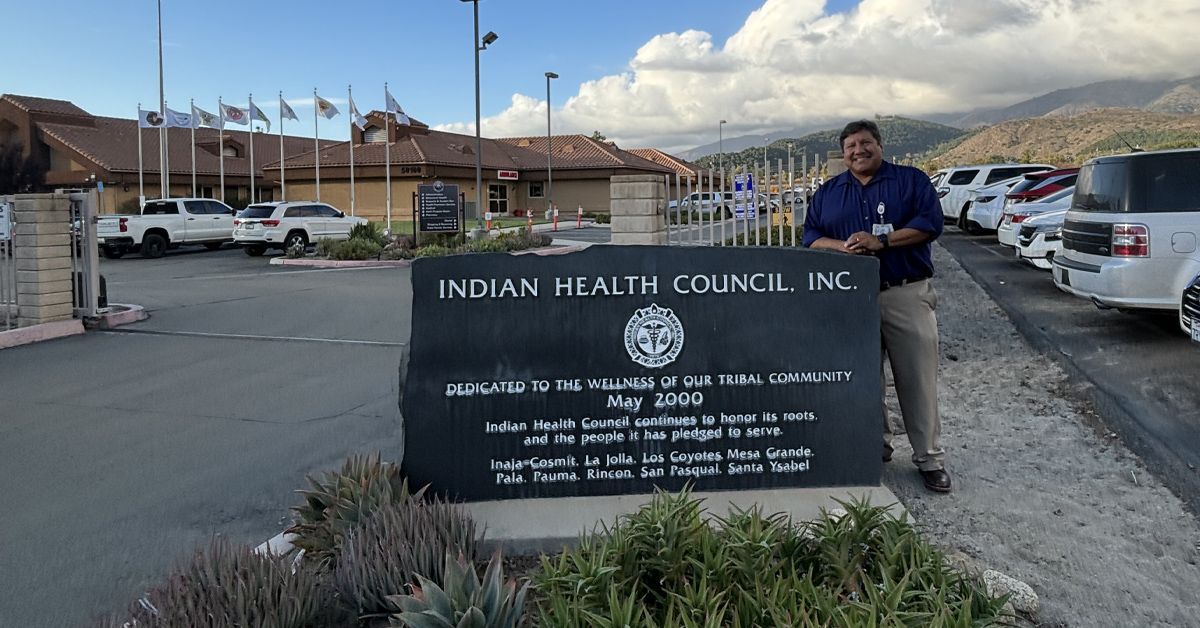Tribal Health Elective Ignites Interest in Indigenous Health Care
School of Medicine Offers MED-235 Tribal Ambulatory Health Care Experience
Story by:
Media contact:
Published Date
Story by:
Media contact:
Topics covered:
Share This:
Article Content
Walking through the parking lot, Dan Calac, MD, is cheerfully greeted, “Hey Dr. Dan!” from a variety of patients. The warm and familiar exchange feels more like old friends reconnecting than a physician-patient greeting, however for Calac who is the chief medical officer at the Indian Health Council (IHC), the greetings are nothing out of the ordinary.
Patients, staff, medical students and visitors are all treated like family at the IHC.
“It was clear that the staff had great relationships with each other and their patients,” wrote Brianna Irons, a University of California San Diego School of Medicine student currently working on a master’s degree at Harvard University. Irons shared about her experience at the IHC in an article entitled Indigenizing Medicine, which was published in Academic Medicine. “When discussing the day ahead, they knew the patients’ stories and families. When patients called or came into the office, they were greeted as relatives. I began to notice a stark difference in the treatment of patients as family, rather than strangers or customers.”
Irons took an elective course, MED-235 Tribal Ambulatory Health Care Experience, as a part of her first-year medical school curriculum at School of Medicine. The course is designed to provide medical students with the opportunity to observe physicians at the IHC, which is located in the Pauma Valley, about an hour northeast of the UC San Diego campus. The IHC clinic provides a range of on-site and outreach services and programs to the northern San Diego County reservations of Inaja-Cosmit, La Jolla, Los Coyotes, Mesa Grande, Pala, Pauma, Rincon, San Pasqual and Santa Ysabel.
Students who take the course gain a better understanding of the provision of health care to Native American populations’ health.
“The class provides the students an opportunity to visit an ambulatory care site and have them really experience not only the tribal atmosphere, but also engage in a multidisciplinary care center,” said Calac. “The students see a variety of patient interactions — pediatric, adolescent, adult and geriatric. They have the opportunity to interpret X-rays, interpret tests and to see what medicine day-to-day is really all about.”
Any first or second year medical student can elect to take MED-235, however priority is given to students who are part of the School of Medicine’s Program in Medical Education-Transforming Indigenous Doctor Education (PRIME-TIDE). This unique 5-year MD/master’s program focuses on training physicians dedicated to providing healthcare to Native populations.
When discussing the day ahead, they knew the patients’ stories and families. When patients called or came into the office, they were greeted as relatives. I began to notice a stark difference in the treatment of patients as family, rather than strangers or customers.
“As the students come out of their undergraduate studies, they are sometimes unclear about what their next steps are,” said Calac. “They start with two years of coursework and it's really important to invigorate their desire to go into medicine by incorporating small amounts of clinical experiences in those first two years. MED-235 is a great opportunity to mesh what they're learning in the class with what they will be experiencing in the third and fourth years.”
Training for the Future
About one third of all Californians live in an area facing a shortage of primary care physicians. Studies indicate that Latinos, African Americans and Native Americans are living in the most underserved areas within the state.
“We’re in one of the most underserved areas across the country,” said Calac. “It’s really difficult to recruit people to come here for a variety of reasons - whether it's the location, people have other family responsibilities, reimbursement is always a consideration, but it's important that we impress upon the students that you're not really doing it for the money. You're going for the passion, and to change the world. That's why we go into medicine, to change the world.”
That desire to change the world can feel daunting to some, as many in tribal communities are hesitant to pursue medical care due to historical trauma.
“Trust in a government structure like the Indian Health Service is rightfully hard to build, but placing relationships at the center of care allowed my preceptor to do so,” wrote Irons, who is a member of the Chickasaw Nation. “This approach to care is an ideal way to promote health equity on a broad scale. Within a space of trust, we might be better able to promote open communication to guide care, health literacy for patients, adherence to treatment regiments, and continuity of care.”
Ultimately MED-235 provides medical students who are interested in service to indigenous populations with the opportunity to learn the unique healthcare approaches and treatment plans for these populations.
“Native populations have unique health care needs,” said Matthew Allison, MD, professor of family medicine and program director for PRIME-TIDE, who is also a member of the Chickasaw Nation. “The approaches to diagnosing and treating those needs can be different from traditional western medicine.”
According to Allison, all the students who have taken MED-235 have found the experience to be very informative for their future careers in medicine.
“I saw the potential to impactfully care for individuals and families,” wrote Irons. “IHS facilities nationwide are understaffed and experience significant turnover. We must encourage Native youth to consider careers in health care.”
Stay in the Know
Keep up with all the latest from UC San Diego. Subscribe to the newsletter today.




